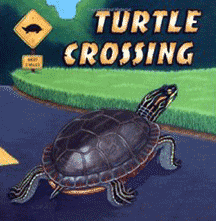Fear the Turtle?
Not in summer
by M.L. Faunce

In truth, the box turtle we’re likely to find in our garden or yard has more to fear from us. Young eastern box turtles are just venturing out after a cold May and a toasty start to June. My dog Rose spotted one in our cul de sac with some excitement on a recent morning walk. I walked the dog and the turtle to the other side of the street to avoid a possible calamity on trash pick-up day.
What I’ve noticed lately on local roads gave me even greater pause. Many of these turtles are venturing out for the first time, and they are not street-smart. Gaze down from your windshield at the road that lies ahead as you barrel along. If you spot a smooth, rock-shaped object with an elongated neck sticking up at a 40-degree angle, it might be a turtle.
When I moved to Southern Anne Arundel County 17 years ago, it wasn’t unusual to see people stopping their cars at the sight of a turtle about to cross the road. People got out of their vehicle, picked up the turtle, carried it to the other side of the road. Then both species went on about their business.
Today, it’s a little different. We still have turtles, but we also have a lot more people on the road. We’re all in such a hurry that we often fail to notice that the rock-like object in a freeze-frame position on the side of the road is part of the natural habitat that surrounds us — and preceded our human presence. The box turtle is the only turtle species that can fully withdraw into a shell to escape predators, but withdrawal is no protection from a ton-and-a-half car or truck. Turtles are faster than you think, and rarely roam far from home, but they’re no match for us humans behind the wheel.
Box turtles can commonly live up to 20 years. Records testify that some have a lifespan as long as 40 or 50 years. In the extreme, they can live to the ripe old age of 100. Maybe that was before roads.
In my yard most years, a dark brown box turtle with black and orange or yellow markings showed up as if on cue to signal the beginning of summer. A split-rail fence with wire to prevent my dog from getting out somehow allowed the turtle to get in. One year, my sister-in-law (out on the deck for an early morning cigarette; I know, I know) reveled in the discovery. There was always some family dog, some guest or family member who discovered in the confines of my backyard by the Bay, an engaging, brave, docile reptile that stuck its head out as greeting and pleased us all enormously. (I’ve also had nesting snapping turtles, but that’s a bigger story.)
As the temperatures climb, and summer sets in, consider slowing down on the road, a habitat we share with the turtle. (You’ll also save gas.) If you want to know more about turtles, visit Jug Bay Wetlands Sanctuary and its 1,400 acres of tidal freshwater wetlands, forest, meadows and fields in southern Anne Arundel County. Learn about the Box Turtle Habitat and Population Study and Box Turtle Census. Visit www.jugbay.org for more information on educational nature programs. And remember to slow down and share the roads with our local wildlife. They were here long before us or our autos.
Prize-winning writer M.L. Faunce has contributed her letters, reflections and stories to Bay Weekly since 1995. Meet her in her own words in our birthday issue: http://www.bayweekly.com/old-site/year08/issuexvi16/leadxvi16_1.html.